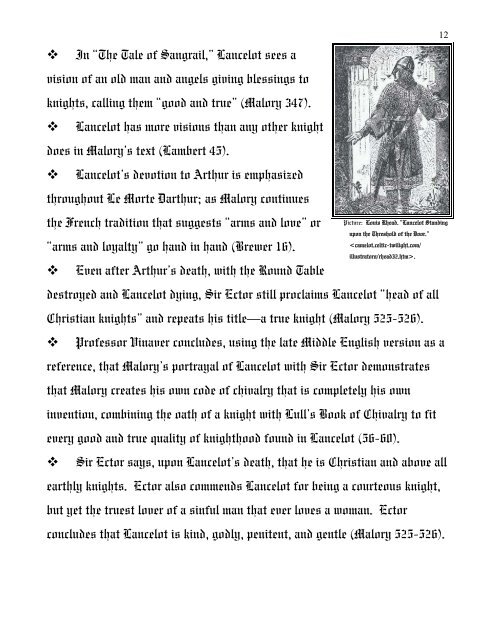A True Knight - Arthuriana
A True Knight - Arthuriana
A True Knight - Arthuriana
You also want an ePaper? Increase the reach of your titles
YUMPU automatically turns print PDFs into web optimized ePapers that Google loves.
In “The Tale of Sangrail,” Lancelot sees a<br />
vision of an old man and angels giving blessings to<br />
knights, calling them “good and true” (Malory 347).<br />
Lancelot has more visions than any other knight<br />
does in Malory’s text (Lambert 45).<br />
Lancelot’s devotion to Arthur is emphasized<br />
throughout Le Morte Darthur; as Malory continues<br />
the French tradition that suggests “arms and love” or<br />
“arms and loyalty” go hand in hand (Brewer 16).<br />
Even after Arthur’s death, with the Round Table<br />
12<br />
Picture: Louis Rhead. “Lancelot Standing<br />
upon the Threshold of the Door.”<br />
.<br />
destroyed and Lancelot dying, Sir Ector still proclaims Lancelot “head of all<br />
Christian knights” and repeats his title—a true knight (Malory 525-526).<br />
Professor Vinaver concludes, using the late Middle English version as a<br />
reference, that Malory’s portrayal of Lancelot with Sir Ector demonstrates<br />
that Malory creates his own code of chivalry that is completely his own<br />
invention, combining the oath of a knight with Lull’s Book of Chivalry to fit<br />
every good and true quality of knighthood found in Lancelot (56-60).<br />
Sir Ector says, upon Lancelot’s death, that he is Christian and above all<br />
earthly knights. Ector also commends Lancelot for being a courteous knight,<br />
but yet the truest lover of a sinful man that ever loves a woman. Ector<br />
concludes that Lancelot is kind, godly, penitent, and gentle (Malory 525-526).


